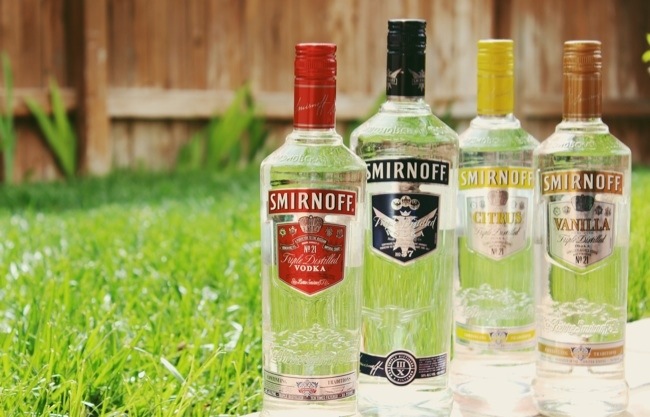
This is Walk the Line: a series where I explore the entire product lines of the most popular liquor brands together with a panel of friends and tasters. Click here to view the entire Walk the Line series.
Smirnoff is not only the best-selling vodka in the world, but it’s the best-selling spirit brand in the world, too. While most of it’s varieties are just in different flavors, I stuck with what I consider to be the basics: two versions of Smirnoff and two classic vodka flavors. All in all, Smirnoff falls right in the middle: for the price, you could do much, much worse, but it’s not a perfect vodka.
Smirnoff. This is the standard red label Smirnoff vodka, also known as “Recipe No. 21.” Distilled from a corn, 80 proof, and selling for $10-15 a bottle, Smirnoff is a pretty safe buy. Tasters found it had a bit of an alcohol bite, particularly in the smell, but that it was a pretty smooth-tasting vodka overall.
Smirnoff Blue Label. Also known as “Recipe No. 57,” Blue Label is 100 proof and is slightly more expensive than the Red Label ($17). It really ignites your taste buds all around when you sip it and tasters found that the burn you get from it is a significant step up from Red Label. There are a few reasons to choose Blue Label over Red: to make infused vodkas, to make stronger cocktails, because you have the extra money to spend, or…let’s be honest here: because you want to get drunk faster.
Smirnoff Citrus. Citrus is one of the “original” vodka favors, from way back in the days when Fruit Loop vodka was unheard of. Citrus vodka is recommended when you make a Cosmopolitan. Smirnoff Citrus has a fresh, clean, and dry lemon flavor. Tasters said it was very smooth and one said they could easily sip it on the rocks. For $14, this is a great choice if you’re looking to incorporate some vodka flavors into your home bar without embarrassing yourself.
Smirnoff Vanilla. The Vanilla vairety is quite a bit sweeter than Citrus, but still fells like a classic vodka flavor. Tasters liked it in general, and said they could see this one used in a Chocolate Martini or give White Russians a nice flavor boost. The taste of Vanilla felt a little manufactured, particularly when compared to the Citrus, but like the other Smirnoffs, Vanilla is a decent buy at $14.








